TOILETS IN JAPAN
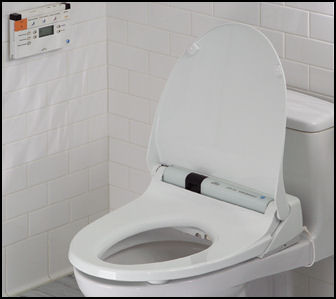
Most homes have Western-style toilets whereas many public rest rooms have mainly Asian-style ones. An Asian toilet is regarded by Asians as more hygienic than a Western one because no part of the body touches it. Asians also find it easier to squat over them than Westerners do.
When Western toilets were first introduced in Japan instructions were provided that showed boys standing in front of the toilet and a girl sitting down. Many Japanese were not sure how to use them and squatted while standing on the seat.
Japan has fewer toilets connected to sewers than any other developed country. More than half of all Japanese homes have toilets with a built-in bidet (water-squirting butt cleaner) and blow dryer. As a water saving measure, some toilets have a small sink that uses the water being stored for the next flush (remember also toilets are often in a separate room from the sink and bathroom so you need something like that to wash your hands).
Many public rest rooms are coed, with urinals in the front for men and separate toilets behind closed doors for men and women. Women's restrooms sometimes have urinals for children. Sometimes public rest rooms don't have toilet paper (for this reason always carry tissue with you). Large rest rooms have long rows of Asian-style toilets with one Western-style toilet at the end.
Good Websites and Sources: Good Photos at Japan-Photo Archive japan-photo.de ; Wikipedia article Wikipedia ; Japan Times Article search.japantimes.co.jp ; Tokyo Toilet Map with Pictures asahi-net.or.jp ; Toilets: Japan links.net/vita/trip/japan/toilets ; Toto Washlets totousa.com
Links in this Website: HOMES IN JAPAN Factsanddetails.com/Japan ;ROOMS AND APPLIANCES IN JAPAN Factsanddetails.com/Japan ; BATHING IN JAPAN Factsanddetails.com/Japan ;HYGIENE AND CLEAN FREAKS IN JAPAN Factsanddetails.com/Japan
Bathrooms in Japan
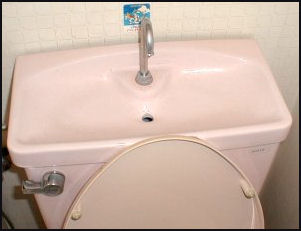
hand washing thing
on top of Japanese toilet Bathrooms and toilets have traditionally been in separate rooms. The bath-shower-sink washing room is often in separate room from the toilet.
A typical bathroom has bathtub, smaller than ones people are used to in the United States. Showers tend to have hand-held shower fixtures that can be hooked up to a head-high attachment on the wall. Japanese often shower in a squatting position or sitting on a stool on the floor next to the bathtub. The shower head is connected to a hose that can be held in the hand or hooked to the wall.
Some people keep wind bells in their houses in the summer time in because the tinkling makes them feel cooler. In the old days, wind chimes were hung on the eaves of the four corners of the house to ward of evil spirits.
Public restrooms are surprisingly clean and modern and almost always have toilet paper. David Sedaris wrote in The Guardian, “With meals I drank tea, which leads me to another great thing about Japan — its bathrooms. When I was younger they wouldn't have mattered so much. Then I hit 50 and found that I had to pee all the time. In Tokyo, every subway station has a free public men's room. The floors and counters are aggressively clean and beside each urinal is a hook for hanging your umbrella. [Source: David Sedaris, The Guardian July 15, 2011]
History of Toilets in Japan
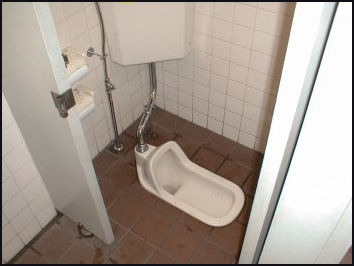
typical Asian-style
public toilet The remains of 50 toilets were found in Fujiwarakyo (present-day Kashihara, Nara Prefecture), the capital of Japan from 694 to 710. There were of two types: simple holes in the ground and primitive “flush” toilets set over specially dug gutters. Both types were constructed in such a way that their users faced north.
In the old days human waste was collected and used for fertilizer. Excrement was considered so valued that landowners owned the rights to it not the renters who produced it. Renters however did own the rights to their urine. Excrement was saved, stored in tanks and was classified into five grades in accordance with suitability for fertilizer. The waste of rich people was regarded as the best because their diet was better. The lowest grade came from prisons. Farmers continued to collect human waste from the cities until the 1930s. Some merchants made deals with farmers to exchange their waste for eggplants and white radishes.
Plumbing and toilets were not widely used until after the Great Tokyo earthquake in 1923 when they importance sanitation to reduce disease was realized. After World War II, Western toilets became more widespread. Toto and other companies borrowed technology from France, the United States and Switzerland and, as the Japanese have done with other technologies, improved it and adapted it their own purpose.
One idea that Toto developed that didn't pan out was the female urinal, a cone-like devise that rose from the floor. Several hundred were made in the 1950s and 60s. One of the last remain ones can be seen in Japan's National Stadium, built for the 1964 Summer Olympics. Japanese inventors had been experimenting with women’s urinals for some time. Nineteenth-century earthenware models were shaped like open umbrellas.
In 1977, shipments of Western-style toilets overtook Asian-style ones for the first time. The manufacturing of squat style toilets ended in 2003,
Toto imported a bidet-toilet , called Wash Air Seat from American Bidet Co, in 1964. Two years later it produced its own version. In 1980 Toto introduced the Washlet. An advertising campaign for the new toilet in 1982 featured an actress in a flower-print skirt who thrust her rear toward the screen while a song went: “Bottoms want to get washed too.” The ads and the toilets — inspired by American and European toilets with bidets intended for hemorrhoid sufferers and medical use — were a big successes. Imported toilets from Switzerland had been available before that but they cost ¥480,000 the cost of a car. As of 2005, Toto has sold 20 million Washlets and sells about 3 million a year.
Japanese Fascination with Toilets
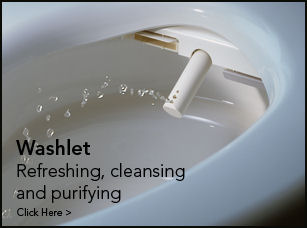
bidet The Japanese are fascinated by toilets. In Japan you can find scholarly symposiums devoted to toilets, solid 24-carat gold toilets, an antique toilet museum, and Toilet Days. Web sites that rate public toilets and inform users that in the old days Japanese used seaweed for toilet paper while Americans used corn cobs. Kiddie television shows show baby hippos eating shit from their mothers followed by hearts.
In April 2000, a study group was formed to study the environmental impact and future of toilets. Because flush toilet use between eight and 12 liter of water per flush, the group is studying new kind of toilets that dehydrate or burn most of the waste, and break down the water with microorganisms.
There is a Japanese proverb that states a pregnant woman who keeps her toilet clean will give birth to a beautiful baby.
In July 2007, a mystery man left 47 envelopes, each containing ¥100,000 at toilets, in local government offices in Saitama, with note with beautiful calligraphy writing that said, “dear visitor who came today...please use the enclosed bequest of ¥10,000 as a fund for your training.”
High Tech Toilets in Japan
The Kyushu-based Toto company, one the world largest producers of toilets, makes high-tech commodes with micro-processors that control an assortment of jets, sprays and devises. The high-tech toilets, known as Washlets have a retractable, self-cleaning wand that shoots a jet of warm water at your bottom. You control the temperatures, pressure and direction of the water with a keypad. Most also have also have driers that dry your bottom with a blast of warm air. The most advanced models cost around $4,000.
Washlets are made by robots and come equipped with bidets and blow dryers that are supposed to eliminate the need for toilet paper. Japanese bidets are notorious for squirting unsuspecting foreigners in the face, drenching their clothes and causing them to spray water all over bathroom because they can't figure out how to turn them off. Bidets have become so popular that Toto has introduced a portable one that fits into a handbag and sells for around $100.
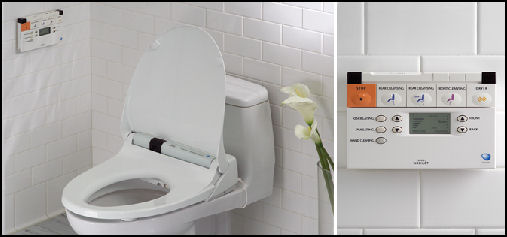
Addressing the problem that women sometimes waste large quantities of water by repeatedly flushing the toilet to "cover up unladylike noises," Toto has equipped new state-of-the-art toilets with an electronic device, called a Sound Princess, which produces flushing sounds that hides the unladylike noises without wasting water. A portable noise-generator, which women can carry in their purse, is also available for use in public rest rooms. Japanese also spend $100 million annually on over-the-counter pills designed to prevent odors while using a toilet.
Many Westerners are baffled by the complicated array of buttons on a Japanese toilet. Describing an experience that he said was the one of the most embarrassing in his life, an American diplomat told the Washington Post he tried to flush the toilet at the dinner party of a Japanese host, but hit the flushing-noise-maker, the blow-dryer and then the bidet button and "watched helplessly as a little plastic arm, sort of squirt gun shaped like a toothbrush, appeared from the back of the bowl and began squirting a stream of warm water across the room and onto the mirror." He had to spend about ten minutes mopping up the water before rejoining the party. [Source: Mary Jordan and Kevin Sullivan, Washington Post]
More than 70 percent of Japanese homes have bidet-style toilets. They are also standard equipment in many hotels, offices and public buildings. All Nippon Airways has them in some of its planes. Many of them are Toto Washlets. More than 28 million Washlets had been sold as of 2010. According to one survey in 2005, 59 percent of homes in Japan have high-tech toilets, compared to 23 percent in 1995. Environmentalist don’t like the trend, complaining the toilets use an exorbitant amount of water and electricity. In houses that have them they use 4 percent of household electricity and 28 percent of the water.
One happy American owner of a Washlet told U.S. News and World Report, “I shouldn’t say this, but sitting on that toilet is actually one of my favorite things of the day now.” Other satisfied Washlet owners include Madonna, Brad Pitt, Will Smith, Demi Moore, Bryant Gumpbel and Howie Mandel. Whoopi Gldberg bought six of them for her New Jersey home. She told Barron’s, “I’m hooked and I’m spreading the word to my friends.” Among the things she adores about them are the heated seats.
In February 2009, manufacturers of electric toilet seats equipped with warm water bidets said their products posed a potential fire risk hazard caused by defects and, in some cases, improper usage. In 2008 there were reports of several toilet fires including ones in which toilets caught fire after urine or toilet cleaning fluid came in contacted with an exposed electrical wire.
Cutting Edge Toilet Technology in Japan
Models currently on the market have temperature control buttons for the bidet water, deodorizers, heated seats, fans that "break down odorous molecules," digital clocks to tell users how long they have been on the toilet, a control panel that offers a choice of flush strengths, and devices that automatically put the seat down when you are done. When Madonna visited Japan for the first time in 12 years in December 2005 she said she longed for Japan’s warm toilet seats.
The idea of the high-tech toilets, one researcher told the Washington Post is to make the bathroom a place where people can relax. In a Toto laboratory, volunteers check out new bathtubs with electrodes attached to their head that "measure brainwaves" and "the effects of bathing on the human body."
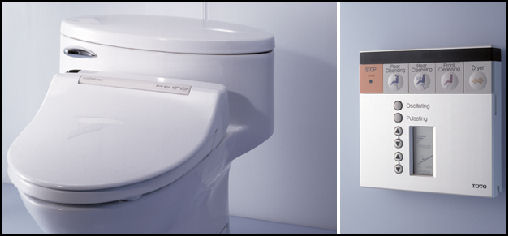
Matsushita and Toto are working on smart toilets that measure "input" and "output" and send the information to health care services. These toilets talk to their users, take their weight and blood pressure, measure body fat using electric currents, measure chemicals in the urine to determine glucose levels and, someday, cancer, and send results online to medical facilities. These toilets are being offered for $4,000 in new houses built by Daiwa house. Some new toilets have ejector-seat like contraptions that helps elderly people and handicapped people get off the seats.
Toto’s newest Neonest systems have wall control panels, stereos, buttons that adjust water pressure and air purification. There are also modals that offer massages with gentle pulses of water and anticipate the approach of users with sensing devises and open the lid automatically so you don’t have to touch anything and sends out “etiquette” music of river and bird sounds and employs deodorizers that use activated oxygen to remove odors a the molecular level and release rose and cherry blossom fragrances. Among those who have purchased them are the actor Will Smith.
Neil A. Martin of Barron’s called the Toto $5,000 Neorest 550 — the Maserati of plumbing.” “As you approach the lid rises in greeting. The seat heats up. A catalytic convertor snaps to attention ready to absorb the faintest of unfortunate odors, Then you pick the sound effects — anything from Mozart to simulated toilet flushing to the crash of ocean waves. Folks in the living room may wonder what — s going on in there — but at least they won’t hear something worse. Toward the end a robotic bidet arm swings into action. We’ll skip the details except to say that its completes its duties with a warm-air dryer. As you take your leave, the lid closes and Neorest automatically flushes.”
There are toilets with cleansing water sprays drying-action air blasts. Eco models have sensors that measure how much water is necessary for each flush and a time memory that measures when the toilet is most heavily used and warms up the seat in advance for those time,
In December 2006, Matsushita introduced a new self-cleaning toilet, costing between $2,500 and $3,500, that is made from a new glass material and is said to never need cleaning. Toto was developed toilets with a tornado-like flush and cleaning cycle that wipes away all waste from the toilet and offers an extra wide seat for sumo wrestlers.
'Washlet' Honored
In July 2012, Jiji Press reported: “The Japan Society of Mechanical Engineers said it has picked Toto Ltd.'s 1980 Washlet G toilet seat, which had a warm-water shower unit to wash users' bottoms, for its fiscal 2012 mechanical engineering heritage list along with four other products. "It was an honor for the toilet seat to be the first household appliance item to receive such recognition," a spokesperson for the Kitakyushu-based company said, adding that the award amounted to recognition of the Washlet's historical and cultural significance. [Source: Jiji Press, July 25, 2012]
Toto had imported and sold U.S.-made medical toilet seats that were used for the treatment of hemorrhoids, but these were not popular. In 1978, the company decided to develop its own products, changing the angle of spray nozzle, as well as the temperature and volume of the water, to suit Japanese people. Its shower toilet seats are now widely used in households throughout the nation.
In its annual mechanical engineering heritage list, the society also selected the Yoshinoyama Ropeway in Nara Prefecture; the Ricopy 101 desktop copier, developed by the predecessor of Ricoh Co.; railroad operator Tokyu Corp.'s 5200 EMU and 7000 EMU stainless steel railcars; and the Ikegai standard engine lathe No. 1, the oldest power lathe in existence in Japan, which was made by the founding brothers of Ikegai Corp. A total of 55 mechanical engineering heritage items have been listed since the designation was created in fiscal 2007.
Toilet Companies in Japan
Based in Kitakyushu in Kyushu, Toto employees around 1,500 engineers and dominates the toilet industry in Japan with 65 percent share and sales of around 3 million toilets a year. It closet rival, Inax, has 25 percent.
Kyoji Asada is one of the top toilet designers for Toto. He takes great pride in his job, working 50 to 60 hour work weeks to come up with new innovation and making the rounds of existing toilets to see how they are holding up. He told the Washington Post. “Going to the toilet should be about relaxation, comfort and cleanliness. I strongly believe the Japanese have the cleanest and most comfortable toilets in the world.”
Security is tight in the Toto Lab. For experiment on flushing action engineers use artificial human waste and develop urinals with less splash back and bowl surface that are smooth even a gecko can”t walk on them. Asada told the Washington Post, “Maybe we can’t build the perfect toilet. But we can build the toilet that no one has yet imagined. That is our mission.”
Japanese toilet-makers are hoping to sell their high-tech models overseas. Toto set the goal of selling 140,000 Washlets abroad in 2007, a threefold increase from 2004. Their primary targets are China, where they are regarded as status symbols and marketed with ads with the popular actress Kelly Chan, and the United States. They are also sold in Hong Kong, Singapore, South Korea. Thailand, Vietnam, Dubai and Saudi Arabia. Sales have not been as brisk as they have been in Japan.
In the United States standard Washlets sell for $600 and luxury models $1000, with a $150 instillation fee. There are showrooms in New York and Hollywood. They haven’t really caught on. People still don’t realize what they are and few plumbers know how to service them.
Toto was founded in 1917. It celebrated its 90the anniversary in April 2007, the same month it recalled 180,000 Washlets because 29 of them had emitted smoke or caught on fire.
Toto is finding an enthusiastic market for its is high-end toilets, sinks and tubs. They are selling well at home and abroad, especially in China, where sales were up over 40 percent in 2010 and which generated 70 percent of Toto’s operating income. Toto also seems be cashing in the trend in America where people are putting money into renovating their existing homes rather than buying new ones. [Source: Neil A. Martin, Barron’s, August 2010]
On the market in China, Toto President Kunio Harimoto told Barron’s, “China is evolving in a manner similar to Japan , which had no tradition of Western-style toilets before the Washlet was introduced. Incomes are rising and our brand recognition is very high. We expect big things from China in the future.”
Toto’s main rival is Inax.. Sanyo, Panasonic. Toshiba and Hitachi are also getting into the high tech toilet business.
Image Sources: 1)2) Toto (moderb toilets), 3) Jun at Goods from Japan (old toilets)
Text Sources: New York Times, Washington Post, Los Angeles Times, Daily Yomiuri, Times of London, Japan National Tourist Organization (JNTO), National Geographic, The New Yorker, Time, Newsweek, Reuters, AP, Lonely Planet Guides, Compton’s Encyclopedia and various books and other publications.
Last updated July 2011
